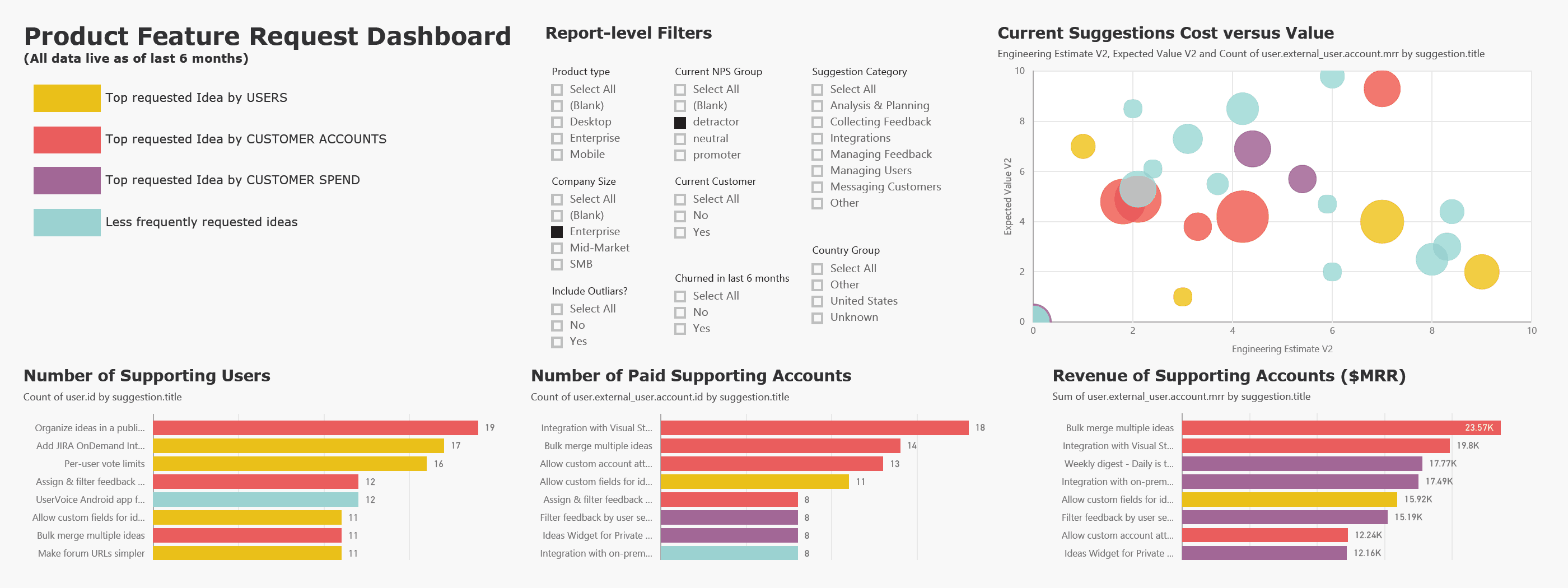Level Up Your Data: Account Views & Advanced Data Export

B2B companies face special challenges when it comes to looking at customer data effectively. At UserVoice, we understand the type of rigorous data that product teams at B2B companies need and we are excited to introduce features that only UserVoice offers. We’re bringing even more flexibility and power to the way you look at your feedback data.
Account Views with Custom Fields
When you’re a B2B company, you often think of your customers in terms of accounts, not individual users. We recognized this as an important need when understanding your product feedback, which led us to create the new account views in UserVoice. Create accounts to get data in two key areas:
- When viewing the list of suggestions, see how many accounts and which accounts support an idea, not just individual users
- Look at an account’s profile page to see all the suggestions and requests supported and submitted by users on that account
Here is an example to how this data could provide another level of insight:Say you have two ideas on your forum each with 100 supporters. With the accounts view, you can see that all the supporters for Idea A are all from the same organization. For Idea B, it also has 100 supporters but it’s supported by 20 different organizations. As a product manager, the way you’d consider and prioritize Idea A and B may now be very different. The two charts below show how you might prioritize features differently based on the number of supporters vs. accounts.

Above, you can see how when you sort by Accounts, a different request becomes top priority.In addition to planning, you can quickly and easily access all the feedback given by an account’s users. This can help you prepare for customer meetings and be ready to respond to their outstanding asks. To support this extra level of data, you have a variety of ways you can pass in any user or account traits you want via direct import, our widget, or API. Create custom fields for any traits that you would like to send in, for example, industry, revenue, subscription plan, or renewal date. When looking at the accounts supporting a suggestion, this information enables you to understand what type of accounts they are, for example if they are an existing customer or prospect or if they’re in a target industry. This gives you the power to sort requests by the criteria that matter most to your business, and see at a glance where the trends are.Find out more in our Knowledge Base article.
Analysis Export
While you have the option to bring data into UserVoice, you can also take data out. Our export functionality enables you to send your feedback data, along with all user and account data, into any analysis tool you choose (i.e. Excel, Tableau, PowerBI, etc) so you have the flexibility to manipulate the data however you need to get to insights faster. We have templates and guides to help you get this running very quickly.This capability may not seem like a big deal but the value it brings is KEY for practicing data-driven product management. We are bringing something to market that previously didn’t exist - the ability to analyze your feedback by customer segments.The following screenshot shows a glimpse at how our product managers use PowerBI to segment and analyze our own product feedback:

This capability enables our PMs to quickly sort their product feedback data by potentially unhappy (i.e. detractors) Enterprise customers and see what the top requested ideas are by users, accounts, and how much they are worth to the business.This opens doors in terms of the questions you can answer with your data. You can find and prioritize ideas to bring to development that will reach the right customers for your goals. And if you know the value of those customers, you can forecast the return of the features you build in terms of dollars, ultimately proving the worth of being data-driven.Learn how to get more out of your data from our Knowledge Base article.

